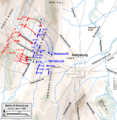Iron Brigade facts for kids
Quick facts for kids Iron Brigade |
|
|---|---|
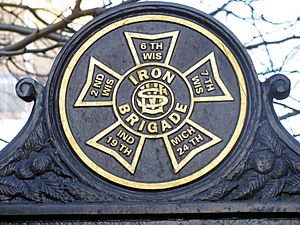
Iron Brigade unit badge, a maltese cross design, showing the Wisconsin, Michigan, and Indiana, Union Army regiments, who were the core of the Brigade, on a historical marker, at Gettysburg National Military Park.
|
|
| Active | October 1861-June 1865 |
| Country | |
| Allegiance | Union |
| Branch | Union Army |
| Type | Infantry |
| Size | Five regiments: 2nd Wisconsin Infantry Regiment 6th Wisconsin Infantry Regiment 7th Wisconsin Infantry Regiment 19th Indiana Infantry Regiment 24th Michigan Infantry Regiment |
| Nickname(s) | The Black Hats, Black Hat Brigade, Iron Brigade of the West, King's Wisconsin Brigade |
| Engagements | American Civil War |
| Commanders | |
| Notable commanders |
Brig. Gen. Rufus King Brig. Gen. John Gibbon Brig. Gen. Solomon Meredith Col. William W. Robinson Brig. Gen. Edward S. Bragg |
The Iron Brigade was a famous group of soldiers in the Union Army during the American Civil War. They were also known by other names like The Black Hats or Iron Brigade of the West. Even though they fought in the eastern part of the United States, their soldiers came from states in the Midwest: Wisconsin, Indiana, and Michigan.
This brigade was known for being very disciplined and fighting bravely. They also had a unique uniform. Sadly, the Iron Brigade suffered more casualties (soldiers killed or wounded) than almost any other brigade in the entire war. The name "Iron Brigade" was used for a few different military units, but this one became the most famous.
Contents
Why Were They Called the Iron Brigade?
The Iron Brigade first included soldiers from the 2nd, 6th, and 7th Wisconsin regiments, and the 19th Indiana regiment. Later, the 24th Michigan regiment joined them. Because these soldiers were all from Western states, they were sometimes called the "Iron Brigade of the West."
They were also known as the "Black Hats." This was because they wore black Hardee hats, which were tall, stiff hats. Most other Union Army units wore blue caps called kepis.
The brigade earned its famous nickname during a battle. On August 28, 1862, they fought bravely against a larger Confederate force led by General Stonewall Jackson. Later, in September 1862, during the Battle of South Mountain, their commander, John Gibbon, led them forward.
General Joseph Hooker saw them fighting. He asked who those brave soldiers were. When he learned they were General Gibbon's Western men, he said, "They must be made of iron!" The soldiers quickly adopted this name, and it became famous.
History of the Iron Brigade
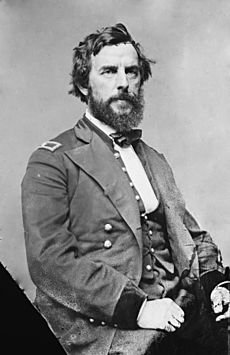

The Iron Brigade officially started on October 1, 1861. It was formed when the 7th Wisconsin regiment arrived in Washington, D.C.. They joined the 2nd and 6th Wisconsin regiments and the 19th Indiana regiment. Their first commander was General Rufus King. At first, they were called King's Wisconsin Brigade.
The brigade fought in its first major battles during the Northern Virginia campaign. This included the Second Battle of Bull Run. After this, the brigade was transferred to the main Union Army, the Army of the Potomac.
The 24th Michigan regiment joined the brigade in October 1862, just before the Battle of Fredericksburg. In February 1863, General Solomon Meredith took command. The brigade was then officially named the 1st Brigade, 1st Division, I Corps.
The Iron Brigade became famous for its bravery, especially on the first day of the Battle of Gettysburg on July 1, 1863. They pushed back a Confederate attack and even captured a Confederate general. The 6th Wisconsin regiment made a famous charge, capturing a Confederate flag and many prisoners. The brigade also helped defend Culp's Hill on the second and third days of the battle.
The Iron Brigade suffered huge losses in battles. For example, at Gettysburg, 61% of their soldiers were killed or wounded. The 2nd Wisconsin regiment lost 77% of its men at Gettysburg. The 24th Michigan regiment lost 80% of its soldiers, which was 397 out of 496 men. This shows how fiercely they fought.
The last soldier of the Iron Brigade, Josiah E. Cass, lived to be 100 years old. He passed away in 1947.
Uniforms of the Iron Brigade
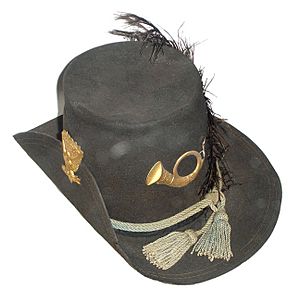
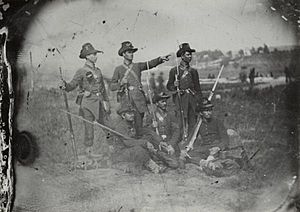
The Iron Brigade's uniform was a bit different from the standard Union Army uniform. It looked more like a dress uniform or a suit. It included:
- A Hardee black hat: This was a tall, black hat with a wide brim. It had a brass bugle (a symbol for infantry), a red circle patch, and brass numbers or letters to show the unit. It also had a brass eagle badge on the side and an ostrich feather.
- Union Frock coat: A long, dark blue coat that reached their mid-thighs. It had a single row of nine brass buttons, each with a federal eagle. The cuffs and collar had light blue trim and two smaller brass buttons.
- Light/dark blue trousers: These trousers went from the waist to the ankles and had pockets. Their color varied between light and dark blue depending on the time of the war and the unit.
- White canvas gaiters: These were white canvas leggings with leather straps. They were worn over the shoes to keep out dirt and stones during marches and battles.
Besides these special uniform items, the soldiers also carried standard Union Army equipment. This included canteens, belts, cartridge boxes for ammunition, bayonets, and haversacks for food.
Weapons Used by the Iron Brigade
The main weapon for many soldiers in the Iron Brigade was the Springfield Model 1861 rifled musket. This was a single-shot, muzzle-loading rifle that fired a .58 caliber bullet. It weighed nine pounds and had a forty-inch barrel. This rifle was the most common weapon used by Union infantry soldiers.
Some regiments, like the 2nd and 7th Wisconsin, used the Lorenz rifle. This was a rifle from Europe. While it was not as common in the Eastern armies, it was still a powerful weapon for the soldiers who carried it.
Other "Iron Brigades"
The name "Iron Brigade" was used for other military units too, both during the Civil War and in later times.
Union Army Brigades
Another brigade in the Union Army was also called the "Iron Brigade." To avoid confusion, it was sometimes called the "Eastern Iron Brigade." This unit included regiments from New York and other states. Even though they served in the same division as the Iron Brigade of the West, the Western brigade got most of the attention from the newspapers.
Other brigades also used the "Iron Brigade" nickname, like one led by General Jesse L. Reno.
Confederate Army - Shelby's Iron Brigade
The Confederates also had an "Iron Brigade." This was a cavalry (horse-mounted) brigade known as the "Missouri Iron Brigade." It was part of General Joseph O. "Jo" Shelby's division and fought in Missouri in 1864.
Modern U.S. Army Units
Today, several units in the U.S. Army still use the "Iron Brigade" nickname.
- The 2nd Brigade of the U.S. 1st Armored Division has been called the Iron Brigade since 1985.
- The 3rd Brigade Combat Team, 1st Infantry Division (United States) was known as the Iron Brigade for many years, from 1917 through World War I, World War II, and Vietnam.
- The 3rd Brigade of the 4th Infantry Division (United States) is also known as the Iron Brigade.
- The 1st Heavy Brigade Combat Team of the 2nd Infantry Division (United States) in South Korea is called the Iron Brigade.
- The 157th Maneuver Enhancement Brigade from Wisconsin is also known as the "Iron Brigade." During World War I, this artillery brigade fired more rounds than any other American brigade.
- The 32nd Infantry Division (United States), formed from Wisconsin and Michigan units, was sometimes called the "Iron Jaw Division." It is now the 32nd Infantry Brigade Combat Team (United States) and is known as the Red Arrow Brigade.
Images for kids
-
24th Michigan Monument, Gettysburg National Military Park
-
The Iron Brigade prepared for battle, at Gettysburg, anchoring the Union Army's southern flank, 10:00–10:45 a.m., on Day 1.
-
Death of General John F. Reynolds as he supervised the deployment of the Iron Brigade early on the first day of the Battle of Gettysburg
See also
 In Spanish: Iron Brigade para niños
In Spanish: Iron Brigade para niños




